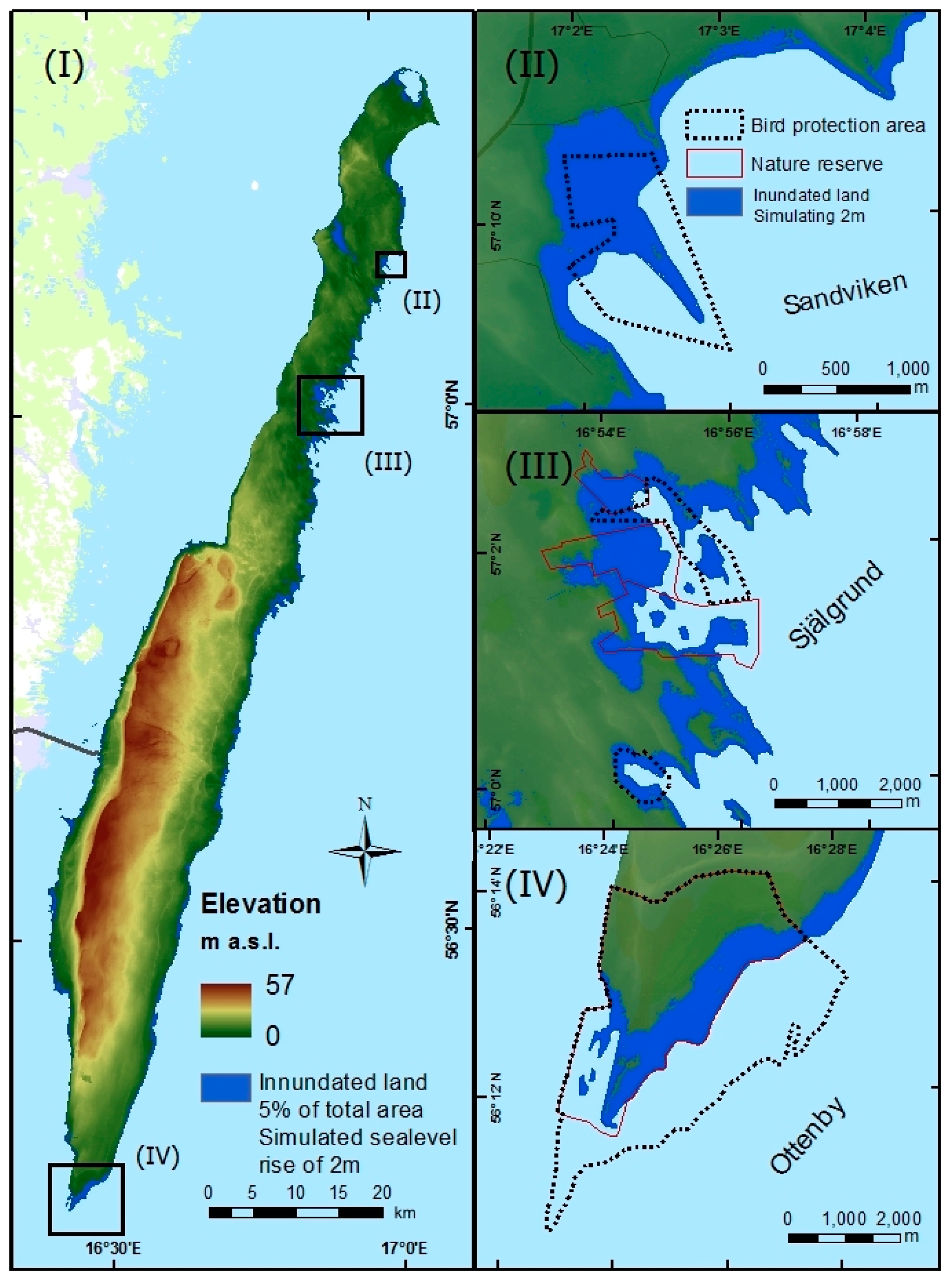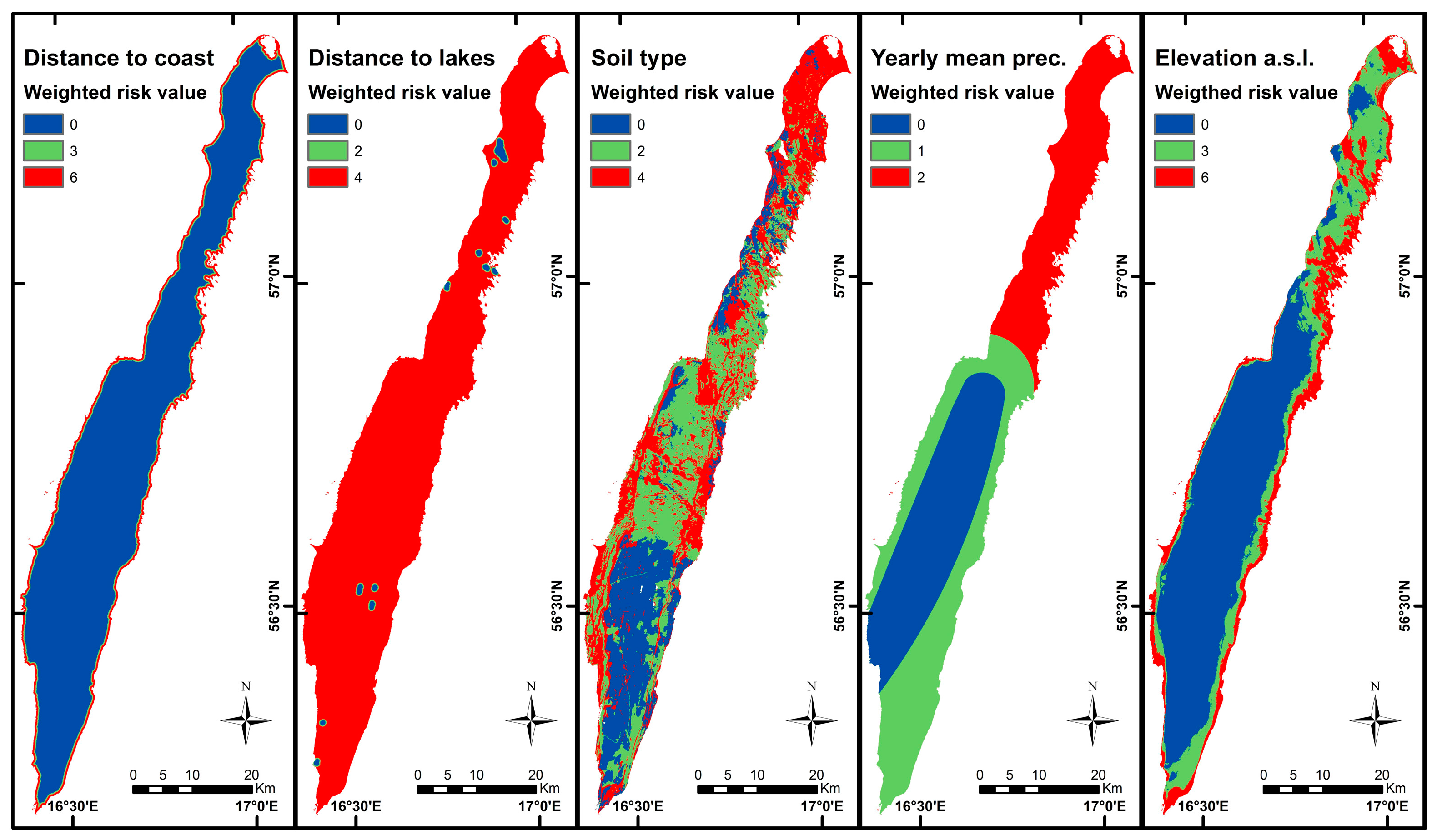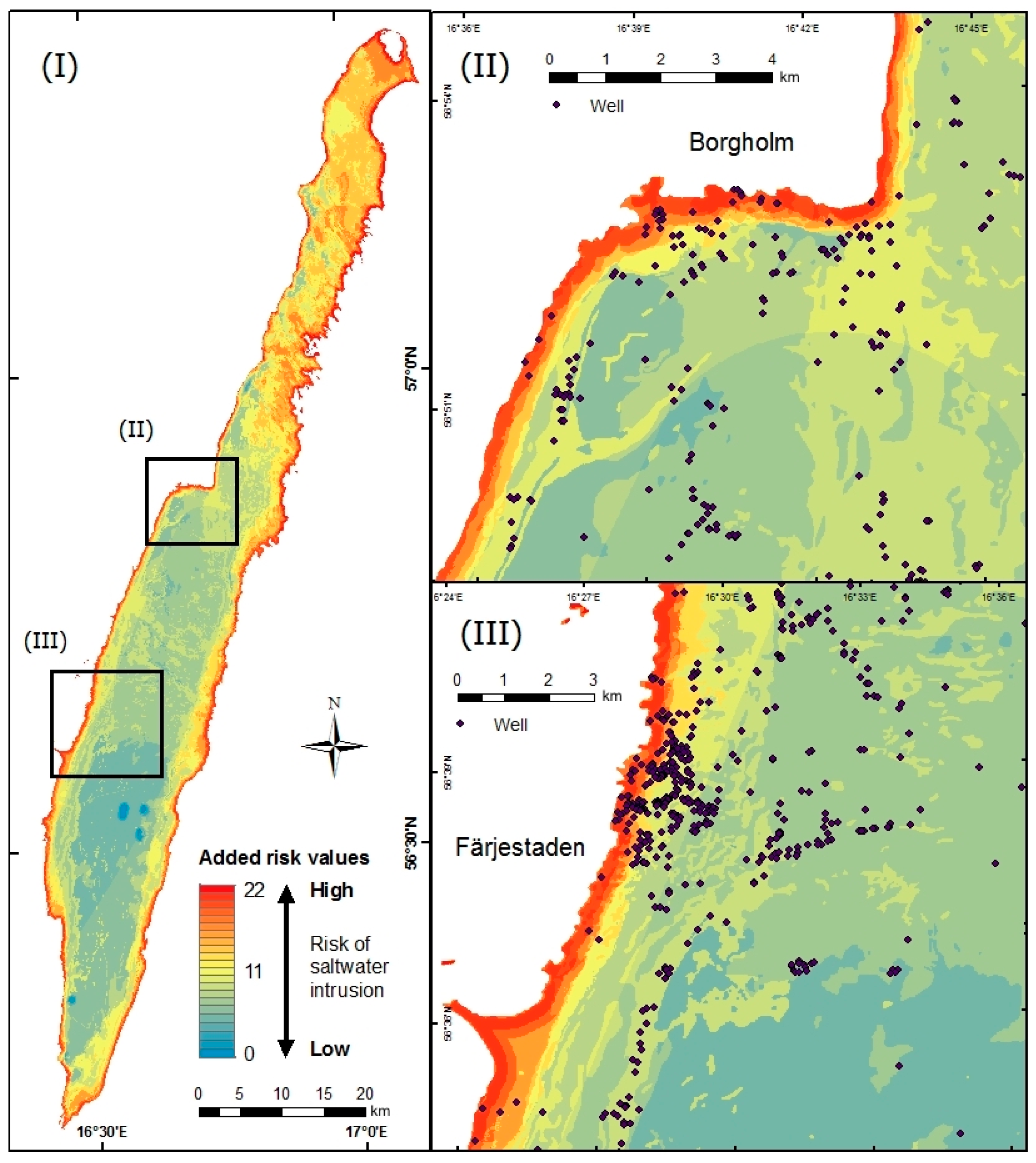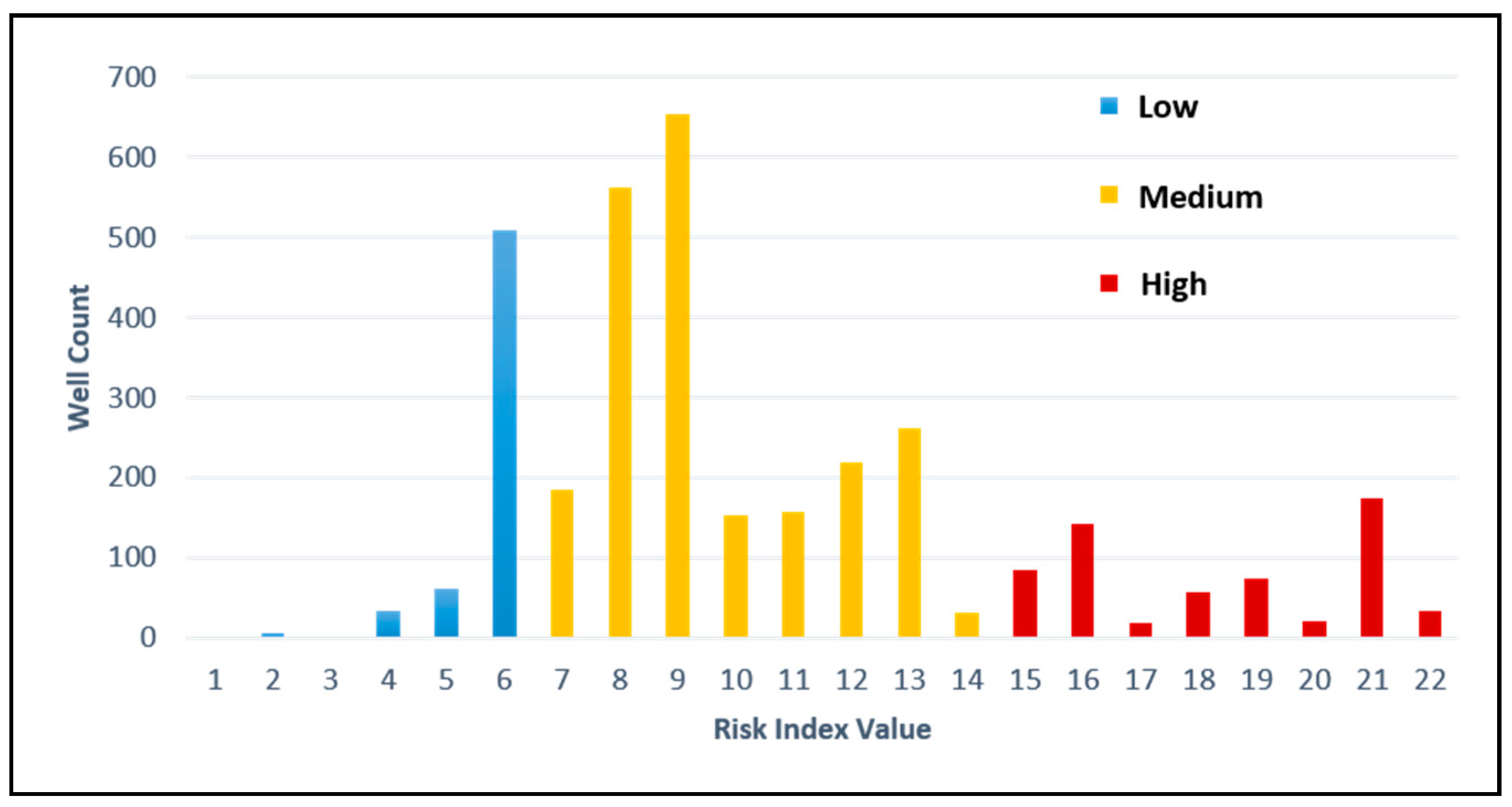Well Salinization Risk and Effects of Baltic Sea Level Rise on the Groundwater-Dependent Island of Öland, Sweden
Abstract
:1. Introduction
1.1. Background and Aim
1.2. Study Area
2. Materials and Methods
- Firstly, a sea level rise was simulated and analyzed with a focus on the direct sea water inundation of wells and land areas. The first part simulated a future sea level rise of 2 m, using ArcGIS, in order to visualize which areas would be directly inundated by seawater as a way to understand and estimate the number of wells that would be covered in saline water—a tipping point for where a freshwater source becomes unusable.
- Secondly, the current baseline risk for the salinization of wells as a result of seawater intrusion into the groundwater system was estimated, considering combined effects of different influential factors. A risk map was created with an index of the risk of saltwater intrusion into wells on the island.
- Parameters were identified and data was collected and assigned specific weight factors.
- Data for each parameter was processed, using specific tools in ArcGIS.
- Each parameter was divided into three subgroups, each with a relative risk value [16].
- Calculations were run and visualized by weighted risk values in maps.
- A final risk map was created, combining all weighted risk values.
2.1. Wells
2.1.1. Spatial Distribution and Well Density
2.1.2. Direct Inundation
2.2. Loss of Land Area
2.2.1. Visualization
2.2.2. Calculation
2.3. Risk Parameters of Saltwater Intrusion
2.3.1. Elevation above Sea Level
2.3.2. Distance to the Baltic Sea
2.3.3. Distance to Lakes
2.3.4. Precipitation
2.3.5. Soil Type
2.4. Weighted Risk Value
2.4.1. Calculations and Mapping
- Di = Weighted risk value index for mapping unit.
- Wj = Weight factor for parameter j.
- Rj = Risk value for parameter j.
2.4.2. Risk Classes and Number of Wells
3. Results
3.1. Well Density and Inundation of Wells
3.2. Inundated Land
3.2.1. Total Loss
3.2.2. Example Areas
3.3. Well Salinization Risk Due to Seawater Intrusion into the Groundwater System
3.4. Risk Map
3.5. Wells at Risk
4. Discussion
4.1. A Rising Sea
4.2. Freshwater Security
4.3. Costs and Actions
4.4. A Precautionary Approach
5. Conclusions
Acknowledgments
Author Contributions
Conflicts of Interest
References
- White, I.; Falkland, T. Management of freshwater lenses on small Pacific islands. Hydrogeology 2010, 18, 227–246. [Google Scholar] [CrossRef]
- Werner, A.D.; Simmons, C.T. Impact of Sea-Level Rise on Sea Water Intrusion in Coastal Aquifers. Natl. Ground Water Assoc. 2009, 47, 197–204. [Google Scholar] [CrossRef] [PubMed]
- Cozzolino, D.; Greggio, N.; Antonellini, M.; Giambastiani, B. Natural and anthropogenic factors affecting freshwater lenses in coastal dunes of the Adriatic coast. J. Hydrol. 2017. [Google Scholar] [CrossRef]
- Gregory, J. Projections of Sea Level Rise. Climate Change 2013: The Physical Science Basis. IPCC AR5 Working Group, 2013. Available online: https://www.ipcc.ch/pdf/unfccc/cop19/3_gregory13sbsta.pdf (accessed on 23 May 2017).
- Ågren, J.; Svensson, R. Postglacial Land Uplift Model and System Definition for the New Swedish Height System RG 2000; Lantmäteriet: Gävle, Sweden, 2007; Available online: https://www.lantmateriet.se/globalassets/kartor-och-geografisk-information/gps-och-matning/geodesi/rapporter_publikationer/rapporter/lmv-rapport_2007_4.pdf (accessed on 31 May 2017).
- Huizer, S.; Karaoulis, M.C.; Oude Essink, G.H.P.; Bierkens, M.F.P. Monitoring and simulation of salinity changes in response to tide and storm surges in a sandy coastal aquifer system. Water Resour. Res. 2017, 53, 6487–6509. [Google Scholar] [CrossRef]
- Von Oelreich, J.; Svenfelt, Å.; Wikman-Svahn, P.; Carlsson-Kanyama, A. Future Sea Level Rise in Municipal Planning. FOI & KTH, Försvarsanalys. 2012. Available online: http://kth.diva-portal.org/smash/get/diva2:563705/FULLTEXT01.pdf (accessed on 23 May 2017).
- Prieto, C.; Destouni, G. Quantifying hydrological and tidal influences on groundwater discharges into coastal waters. Water Resour. Res. 2005, 41, W12427. [Google Scholar] [CrossRef]
- Hellström, M.; Ottvall, R.; Andersson, A.; Lilja Nordin, T.; Waldenström, J.; Lindström, Å. Fågelräkning och Ringmärkning vid Ottenby 2016 [Bird Ringing at Ottenby 2016]; Report; Ottenby Bird Observatory–Swedish Ornithological Society: Degerhamn, Sweden, 2017. [Google Scholar]
- GeoPark Öland. En Liten Geologisk Guide Till Upplevelser På Öland. 2012. Available online: http://www.olandsguiderna.se/images/Geopark-guide.pdf (accessed on 9 May 2017).
- Ölands Turistbyrå. Turistbroschyr 2017. Available online: https://issuu.com/olandsturistbyra/docs/turistbroschyr_2017 (accessed on 9 May 2017).
- Kohl, R.; Carlson, C.; Wangemann, S. Herbicide Leaching Potential through Road Ditches in Thin Soils over an Outwash Aquifer. Appl. Eng. Agric. 1994, 10, 497–503. [Google Scholar] [CrossRef]
- Augustsson, A.; Uddh Söderberg, T.; Jarsjö, J.; Åström, M.E.; Olofsson, B.; Balfors, B.; Destouni, G. The risk of overestimating the risk—Metals in groundwater near contaminated glass waste deposits and exposure via drinking water. Sci. Total Environ. 2016, 566–567, 1420–1431. [Google Scholar] [CrossRef] [PubMed]
- Larrson, M.; Rosander, M. Översvämningsrisker på Öland—Vattenplanering i ett Förändrat Klimat; Länsstyrelsen: Kalmar, Sweden, 2015. [Google Scholar]
- Länsanalyser, SMHI 1991–2013. Available online: http://www.smhi.se/klimat/framtidens-klimat/lansanalyser/#00_Sverige,t2m_meanAnnual,ANN (accessed on 8 May 2017).
- Ebert, K.; Ekstedt, K.; Jarsjö, J. GIS analysis of effects of future Baltic Sea level rise. Nat. Hazards Earth Syst. Sci. 2016, 16, 1571–1582. [Google Scholar] [CrossRef]
- Ströberg, A.; Ebert, K.; Jarsjö, J.; Frampton, A. Contaminated area instability along Ångermanälven River, Northern Sweden. Environ. Monit. Assess. 2017, 189, 118. [Google Scholar] [CrossRef] [PubMed]
- Gutierrez, B.T.; Plant, N.G.; Thieler, E.R. A Bayesian network to predict coastal vulnerability to sea level rise. J. Geophys. Res. Earth Surf. 2011, 116. [Google Scholar] [CrossRef]
- Hossam, H.E.; Ragaa, E.S.; Atef, A.Q.; Ahmad, M.N. Determining groundwater protection zones for the Quaternary aquifer of northeastern Nile Delta using GIS-based vulnerability mapping. Environ. Earth Sci. 2013, 68, 313–331. [Google Scholar]
- Barlow, P. Ground Water in Freshwater-Saltwater Environments of the Atlantic Coast; U.S. Geological Survey: Reston, VA, USA, 2003. Available online: http://purl.access.gpo.gov/GPO/LPS54260 (accessed on 9 May 2017).
- Rushton, K. Groundwater Hydrology: Conceptual and Computational Models; John Wiley & Sons, Ltd.: Chichester, UK, 2003. [Google Scholar] [CrossRef]
- Klassen, J.; Allen, D. Research papers: Assessing the risk of saltwater intrusion in coastal aquifers. J. Hydrol. 2017. [Google Scholar] [CrossRef]
- Karlsson, R.; Hansbo, S. Jordarters Indelning Och Benämning. Svenska Geotekniska Föreningen. 1992. Available online: http://docplayer.se/11017438-Jordarternas-indelning-och-benamning.html (accessed on 10 May 2017).
- Sveriges Nationalatlas (SNA). Berg Och Jord, 2nd ed.; Sveriges Nationalatlas: Stockholm, Sweden, 2009; Volume 3, ISBN 9789187760563. [Google Scholar]
- Gogu, R.; Dassargues, A. Current trends and future challenges in groundwater vulnerability assessment using overlay and index methods. Environ. Geol. 2000, 39, 549–559. [Google Scholar] [CrossRef]
- Brunnsarkivet, SGU. Available online: https://apps.sgu.se/kartvisare/kartvisare-brunnar.html?zoom=348313.6192553048,6150814.150664143,870234.6630973928,6410934.670905184 (accessed on 1 May 2017).
- Tularam, G.; Keeler, H. The study of coastal groundwater depth and salinity variation using time-series analysis. Environ. Impact Assess. Rev. 2006, 26, 633–642. [Google Scholar] [CrossRef]
- Nuse, B.; Cooper, R.; Hunter, E. Prospects for predicting changes to coastal wetland bird populations due to accelerated sea level rise. Ecosphere 2015, 6, 1–23. [Google Scholar] [CrossRef]
- Mossmark, F.; Hultberg, H.; Ericsson, L. Recovery from groundwater extraction in a small catchment area with crystalline bedrock and thin soil cover in Sweden. Sci. Total Environ. 2008, 404, 253–261. [Google Scholar] [CrossRef] [PubMed]
- Eissa, M.; Thomas, J.; Pohll, G.; Shouakar-Stash, O.; Hershey, R.; Dawoud, M. Groundwater recharge and salinization in the arid coastal plain aquifer of the Wadi Watir delta, Sinai, Egypt. Appl. Geochem. 2016, 71, 48–62. [Google Scholar] [CrossRef]
- Leppäranta, M.; Myrberg, K. Physical Oceanography of the Baltic Sea; Springer Science & Business Media: Berlin/Heidelberg, Germany, 2009; p. 278. ISBN 978-3-540-79702-9. [Google Scholar]
- Nerheim, S.; Södling, J. Havsnivåer i Kalmar Län (Sea Levels in Kalmar Municipality); Report 66; Swedish Hydrological and Meteorological Institute (SMHI): Norrköping, Sweden, 2014. (In Swedish) [Google Scholar]
- Torresan, S.; Critto, A.; Rizzi, J.; Marcomini, A. Assessment of coastal vulnerability to climate change hazards at the regional scale: The case study of the North Adriatic Sea. Nat. Hazards Earth Syst. Sci. 2012, 12, 2347–2368. [Google Scholar] [CrossRef] [Green Version]







| Data | Format | Reference | Production Date | Resolution |
|---|---|---|---|---|
| Digital elevation model (DEM) | Raster | Swedish National Land Survey | 2009 | 2 m |
| Soil type | Vector (polygon) | Swedish Geological Survey | 2014 | - |
| Wells | Vector (point) | Swedish Geological Survey | 2010 | - |
| GSD-General Map | Vector (polygon) | Swedish National Land Survey | 2017 | - |
| Mean annual precipitation | Raster | Swedish Meteorological and Hydrological Institute | 1991–2013 | 4000 m |
| Parameter (j) | Subdivision Value | Risk Value (R) | Weight Factor (W) | Weighted Risk Value |
|---|---|---|---|---|
| Distance to coast (m) | <300 300–500 >500 | 2 1 0 | 3 | 6 3 0 |
| Distance to lakes (m) | <300 300–500 >500 | 0 1 2 | 2 | 0 2 4 |
| Soil type | Coarse sediments Fine sediments Bare bedrock No data | 2 1 0 No data | 2 | 4 2 0 No data |
| Prec. yearly average (mm) | <550 550–600 >600 | 2 1 0 | 1 | 2 1 0 |
| Elevation meters above sea level (m.a.s.l.) | <5 5–10 >10 | 2 1 0 | 3 | 6 3 0 |
© 2018 by the authors. Licensee MDPI, Basel, Switzerland. This article is an open access article distributed under the terms and conditions of the Creative Commons Attribution (CC BY) license (http://creativecommons.org/licenses/by/4.0/).
Share and Cite
Eriksson, M.; Ebert, K.; Jarsjö, J. Well Salinization Risk and Effects of Baltic Sea Level Rise on the Groundwater-Dependent Island of Öland, Sweden. Water 2018, 10, 141. https://doi.org/10.3390/w10020141
Eriksson M, Ebert K, Jarsjö J. Well Salinization Risk and Effects of Baltic Sea Level Rise on the Groundwater-Dependent Island of Öland, Sweden. Water. 2018; 10(2):141. https://doi.org/10.3390/w10020141
Chicago/Turabian StyleEriksson, Marcus, Karin Ebert, and Jerker Jarsjö. 2018. "Well Salinization Risk and Effects of Baltic Sea Level Rise on the Groundwater-Dependent Island of Öland, Sweden" Water 10, no. 2: 141. https://doi.org/10.3390/w10020141





